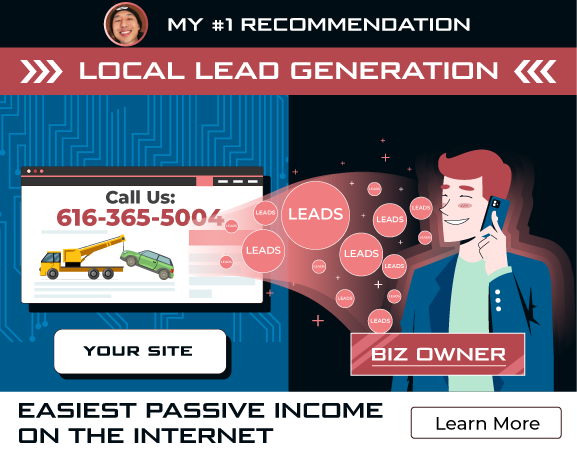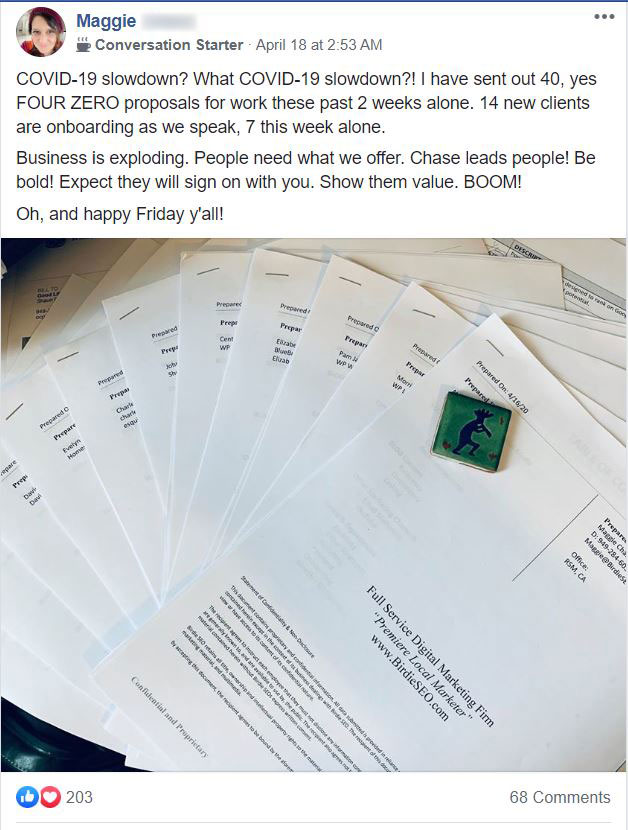
Pros
Low startup costs
No inventory management
Wide range of products
Easy to set up
Customization and personalization
Scalable
Less risky
Global reach
Flexibility and convenience
Many niches with little to no competition
Cons
Limited control over product quality
Limited customization options
Dependent on the third-party suppliers
Shipment and fulfillment challenges
Brand differentiation difficulties
Intellectual property concerns
Integration issues
Low profit margins
Dependency on paid tools
Artistic expression vs. profitability
Print on demand can make money, but you need to carefully weigh the pros and cons to see if it's the right business for you. The industry is worth over $8.03 billion today, so there's a growing interest among those who want to take advantage of the business potential.
According to Gelato, the entrepreneurs' interest in the print on demand business model has tripled in the last five years because it's flexible and scalable. Grand View Research also notes that the POD business is projected to expand at a CAGR of 25.8% from 2023 to 2030. This growth is driven by the increasing consumer demand for personalized and customized products.
Despite the growing business opportunity, POD has inherent challenges that interested investors should be mindful of. You don't have control over the quality of products you sell, you're dependent on third-party suppliers, and it would be hard to differentiate your brand in such as a saturated market.
A YouTuber named Alex shared how much she realistically made 6 months into her print on demand business on Etsy. She confessed that she didn't make money in her first two months, but the store slowly gained traction after using paid ads. Her growth was slow but steady. She closed her 6th month with $1,146.60 revenue while working a full-time job.
However, an anonymous Reddit poster's experience was more disappointing than Alex's. He sold print-on-demand ornaments on Etsy, but immediately faced product quality issues from suppliers like Printify, IMagine Your Photos, and Pic the Gift. He complained about blurry images, print quality, and poor packaging, which showed the risks of depending on third-party service providers.
This article gives you a closer look at the 10 pros and cons of the print on demand business model. I'll also share real-life examples from people who have done the biz plus their unbiased feedback on its profitability potential.
10 Pros and Cons of Print on Demand Business Model
Pros of Print on Demand Business
1. Low Startup Costs
Print on demand business have low startup costs because of many factors involved. A POD business can be launched online with costs as low as $29/month for print on demand platform subscription. Based on the Quora post, setting up a website on platforms like Shopify can cost as little as $29/month to $299. Plus, some additional expenses for website domain and necessary apps.
Another thing, print on demand businesses don't require bulk ordering. POD products are made to order. So, there's no risk of unsold inventory. This a common financial drain for traditional businesses where unsold items often lead to losses when they are sold at a 50% markdown.
Additionally, POD companies handle production and shipping. According to Warehousing and Fulfillment, the estimated third-party logistics (3PL) costs can range from $200 to $2,000 a month for small businesses, depending on volume. POD services typically include these costs in the price of the product and are included in the product price. This reduce the financial burden on the business owner.
Mark Tilbury shares his firsthand experience with POD. He tested and explore the potential of earning passive income using the business model. So, he launch a product with zero investment and under a different username within 24 hours. He chooses Gelato for its user-friendly platform and global reach.
Then, Mike conducted market research via TikTok. He identifies wall art as a lucrative niche due to its popularity, low production costs, and high profit margins. After that, he outsourced the creation of motivational wall art to Fiverr. This is to overcome his design limitations and time constraints.
Setting up an online store on Etsy, he aimed for a premium presentation and set a higher price point to maintain a 50% profit margin. Despite the competitive nature of Etsy, he managed sales with a clear profit after costs. The venture was considered a success, showing potential for business's growth and scalability. even with no initial investment.
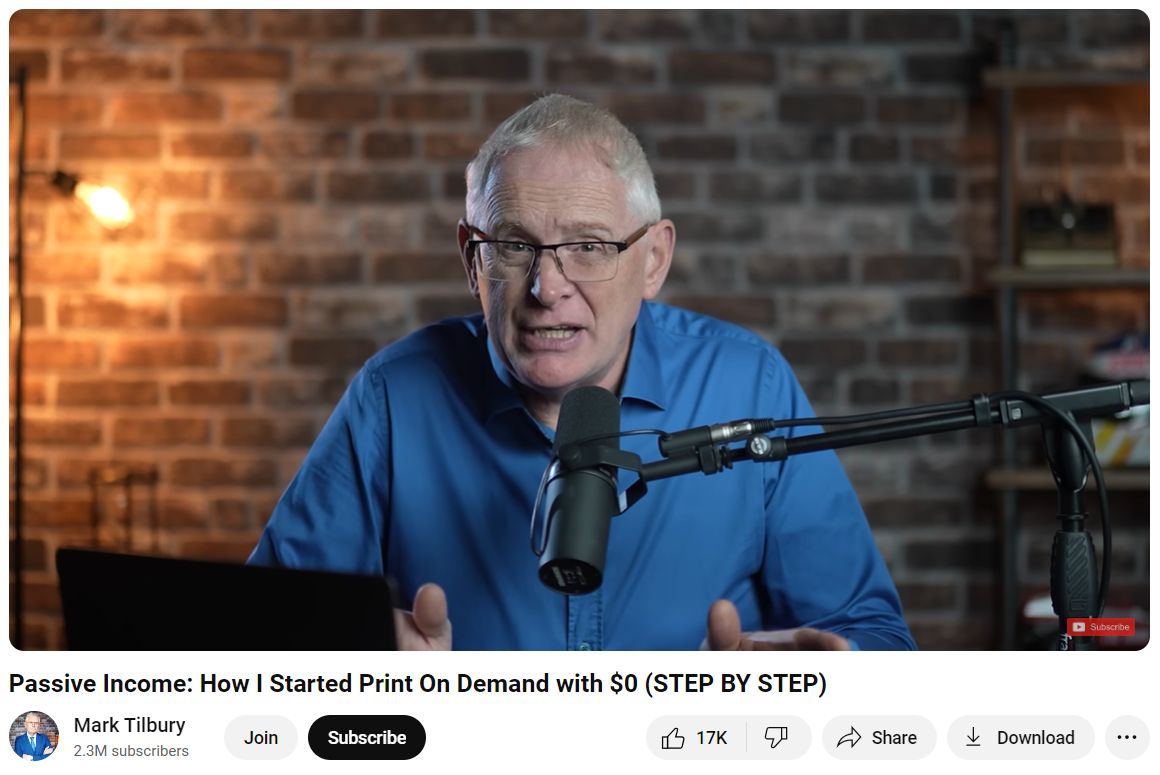
2. No Inventory Management
Print on demand enables businesses to order stock only as needed. This reduces the need for large warehouse spaces and lowering storage costs. It allows for a more diverse approach to inventory management, where goods are produced to meet actual demand rather than based on forecasted demand. This significantly lowers the risk of overproduction and large inventory. It can be costly and tie up capital that could be used more effectively elsewhere.
According to Myos, over 30% of businesses have been impacted. This is because of incorrect stock information. Also, 34% have shipped an order late because they accidentally sold a product that wasn't in stock. By using a POD business model, inventory accuracy and reduce risk of stockouts are implemented.
3. Wide Range of Products
Print on demand businesses with a broader product range have the potential to generate more sales. According to a report by Shopify, stores offering personalization and a wide range of products saw an average increase in sales by 40% compared to those with limited offerings. The variety attracts different customer segments and increase the chances of repeat purchases. However, not all products are profitable to begin with
Joe Robert, in his video titled "Why I Don't Sell T-Shirts & Switched To High Profit Print On Demand Products," shares his transition from selling t-shirts to focusing on higher-profit POD products. Joe addresses the challenge between selling items at high margins versus aiming for high volume sales with lower profits per item.
Robert shares examples of higher-margin products, such as car seat covers and customized shoes. These offer better profit opportunities compared to traditional POD items like t-shirts and mugs.
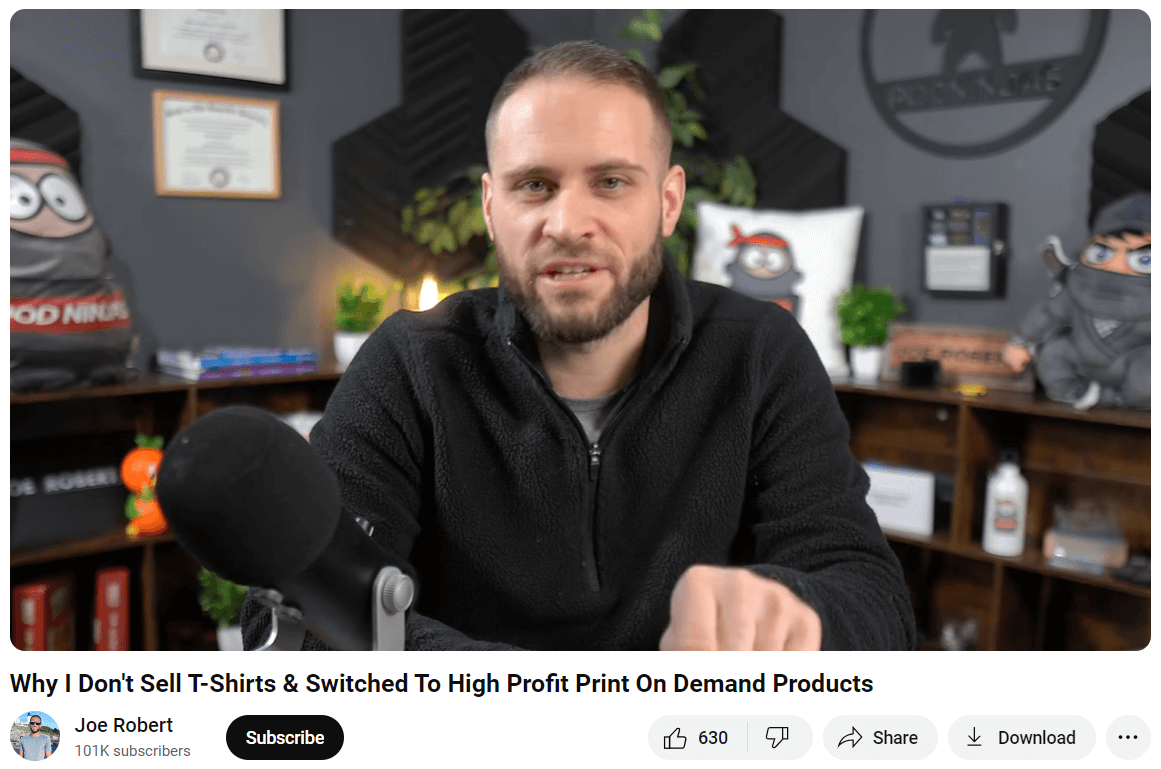
4. Easy to Set Up
Print on demand is easy to setup. This is because POD services offer seamless integration with popular e-commerce platforms like Shopify and Etsy. Entrepreneurs can set up a functional online store without extensive technical skills.
This integration allows for an easy setup process, enabling entrepreneurs to start selling custom products under their brand without handling the production process themselves.
According to a survey by Printful, over 60% of their users were able to set up their online store. They also started selling within a week.
10 Best Ecommerce Integrations for Print on Demand
5. Customization and Personalization
Customization and personalization are key strategies for businesses using Print-On-Demand (POD). This is to make their products stand out and add extra value for customers. According to Deloitte Consumer Review, over 50% of consumers expressed interest in purchasing personalized or customized products. This interest is strong among younger demographics, such as Millennials and Gen Z, who value uniqueness and personal expression in the products they purchase.
6. Scalability
Print on Demand (POD) services have transformed how businesses approach inventory management, production, and fulfillment. This especially for small businesses and startups. The POD model is inherently scalable, adapting fluidly as a business grows. This scalability is a significant advantage for entrepreneurs who are looking to lower risk and investment while maximizing their product offerings.
Hannah Ebeling shared her journey into POD. She started from scratch with no e-commerce background. She explored this venture through platforms like Amazon Merch, Redbubble, and Teespring. Then, focused on aggressive design uploads and niche research with minimal investment.
Hannah drove initial sales through a targeted Instagram strategy. Then, organically on Redbubble. Eventually, she earned $235.44 in the first month from around 200-300 unique designs. This story highlights the potential profit for new sellers in POD. Even the creator's initial uncertainty about earnings. She still believed in the scalability of POD with consistent effort and smart strategy.

7. Reduced Risk
Print on demand (POD) has revolutionized the way small businesses, authors, and artists approach the production and distribution of printed goods. By allowing items to be printed as orders are received, POD reduces risks associated with traditional bulk printing.
8. Global Reach
Print-on-demand allows customers to order from anywhere in the world. It is not bound by geographic limitations unlike traditional brick-and-mortar stores. The POD business also allows customers to customize the product according to their cultural preference and language.
The availability of localized fulfillment centers allowed easier movement of goods from one region to another. For example, if you use Amazon as your POD platform, you get access to 185 fulfillment centers across the globe with 75 of them are located outside the United States. Among the countries that have localized Amazon fulfillment centers include the United Kingdom, France, Germany, and Spain in Europe, Canada in North America, Australia in the Oceania region, and Japan and India in Asia.
9. Flexibility and Convenience
The POD biz offers flexibility because you can manage it from anywhere as long as you have an internet connection. Some POD stores can even be managed through a smartphone. This level of convenience is one of the reasons why print-on-demand is a popular business today. With POD, you don't have to follow a fixed work schedule. So, it's a great side business for those working a full-time job, stay-at-home moms, and students who want to earn extra income.
Print-on-demand is convenient because printing, fulfillment, and customer service can be automated into a system. Your chosen POD platform also handles product creation, shipping, and after-sales. There are many graphic design software available online that will help you create professional-looking designs like Canva, Inkscape, and Printful.
10. Many Niches with Little To No Competition
One of the pros of print-on-demand is that there's relatively less competition with niche products. So, beginners have the opportunity to carve their unique niche without being eaten by the bigger players. Print-on-demand niches are subdivided into specific interests, hobbies, and demographics. Hobbies, for example, is further divided into sub-niches like gardening, gaming, vintage fashion, or toy collection.
Best-Selling Print-on-Demand Niches in 2024 According to Philip Anders

1. Custom Apparel with European Football Team Designs
2. Merchandise with Total Solar Eclipse Designs
3. Milestone Birthday Items for 50th, 40th, and 30th Birthday (or Anniversary)
4. U.S. Election-Related Custom Merchandise
5. Custom Apparel and Merch with Summer Olympics Designs
6. Gifts that celebrate retirement, like mugs and shirts with personalized messages
Cons of Print on Demand Business
1. Limited Control Over Product Quality
The limited control over product quality in a print-on-demand (POD) business is because of third-party suppliers for print fulfillment and shipping. Product quality can be inconsistent since different suppliers may use varying quality materials and printing techniques.
A Reddit user named rowdyjustice is seeking advice from others who own successful Print On Demand (POD) T-shirt businesses. They've been operating on Etsy for five months, generating around $17,000 in revenue since September through Printify.
Despite the success, they're facing significant concerns regarding print quality, which has led to numerous returns. Before scaling their business with advertisements, they're eager to address these quality control issues. They're looking to connect with peers in the POD t-shirt space to exchange insights on handling quality issues and to learn about the providers others use, without going into specifics about niche or products. They express gratitude in advance and encourage fellow entrepreneurs to continue thriving.
The user is at a critical point where they're considering expanding their business but are cautious due to existing quality control challenges. This reflects a common dilemma in scaling small businesses—balancing growth with maintaining product quality. Their approach, seeking peer advice while being respectful of privacy, highlights the value of community support in navigating business hurdles.
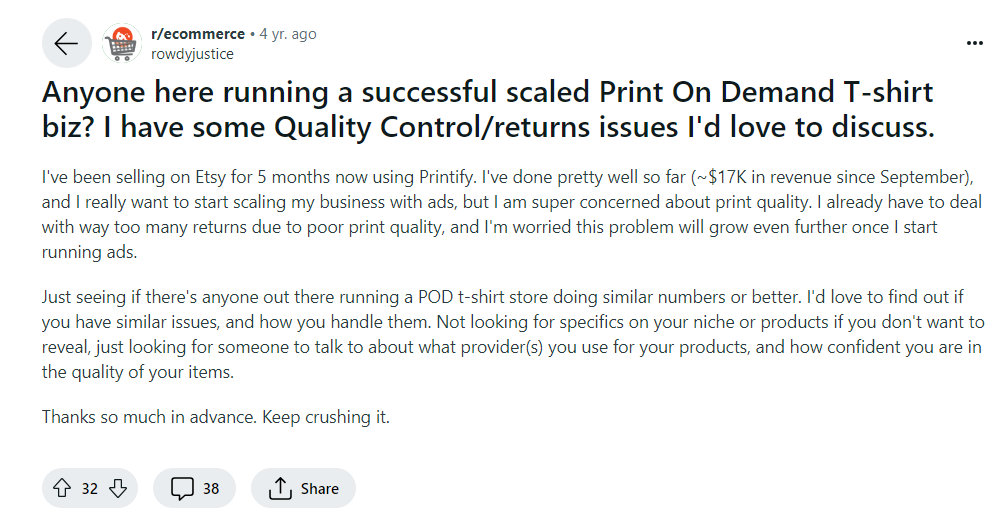
2. Limited Customization Options
While POD services excel in design customization, they fall short in providing options. This involves material quality, color options, and product variants. The limitation arises because POD companies streamline their operations around a select range of products. This is to maintain efficiency and cut costs. As a result, businesses that rely on POD may find themselves unable to meet specific customer demands for customization .
For instance, if a customer desires a t-shirt in a particular shade of color or fabric type. But it's not offered by the POD service. Hence, the business cannot fulfill this request. This impacts customer satisfaction and limit the marketability for personalized options.
3. Dependence on Third-Party Suppliers
Dependence subjects your business to the operational capacities and policies of the POD supplier. Delays in production or shipping errors can have a direct impact on your business. This affects customer satisfaction and harming your reputation. Since you have little control over these, inconsistence in the service quality can compromise product quality and delivery timelines.
This dependency also limits your ability to respond quickly to market changes or customer demands. Any change in product offerings or designs requires coordination of the third-party supplier. Thus, the success of your business depends on how reliable and efficient your POD supplier is. Their performance plays a key role in your business's success.
4. Shipping and Fulfillment Challenges
High shipping costs and prolonged delivery times, particularly for international orders. This can impact customer satisfaction. Customers today expect fast, if not immediate, delivery of products. When a print-on-demand service can't quickly ship products, it becomes less competitive. This makes it hard for these businesses to keep customers loyal.
According to ProShip, 84% of consumers would abandon a retailer after just one bad delivery experience. Additionally, CB Inisghts data shows 68% of online shoppers prefer to choose retailers offering shorter delivery times. This underlines the importance of swift fulfillment. This emphasizes the need for flexible and efficient delivery options to meet consumer expectations.
5. Brand Differentiation Difficulties
Difficulty in brand differentiation in print on demand business is a challenge that arise. This because the market is taken over with many entrepreneurs doing POD services. Also, sell similar product categories. The main way to stand out in the print-on-demand business is through unique designs. But because many designs are similar or trendy, it's hard to make your brand look different.
In a Quora post, Jim Moore advises against trying to directly compete with large printing companies like Custom Ink on volume and price because it's likely to reduce your profit margins significantly. He shares his own experience with Vistaprint, noting that while he couldn't compete on price, he found a niche in fixing mistakes that the larger companies' automated processes overlooked.
This highlights the value of offering superior customer service and quality, emphasizing that some customers are willing to pay more for a reliable service that gets it right the first time. Jim suggests focusing on creating the best customer experience possible as a way to differentiate from the big players. He acknowledges that the printing industry has largely become commoditized, but still sees room for businesses that can offer something more personalized and dependable.
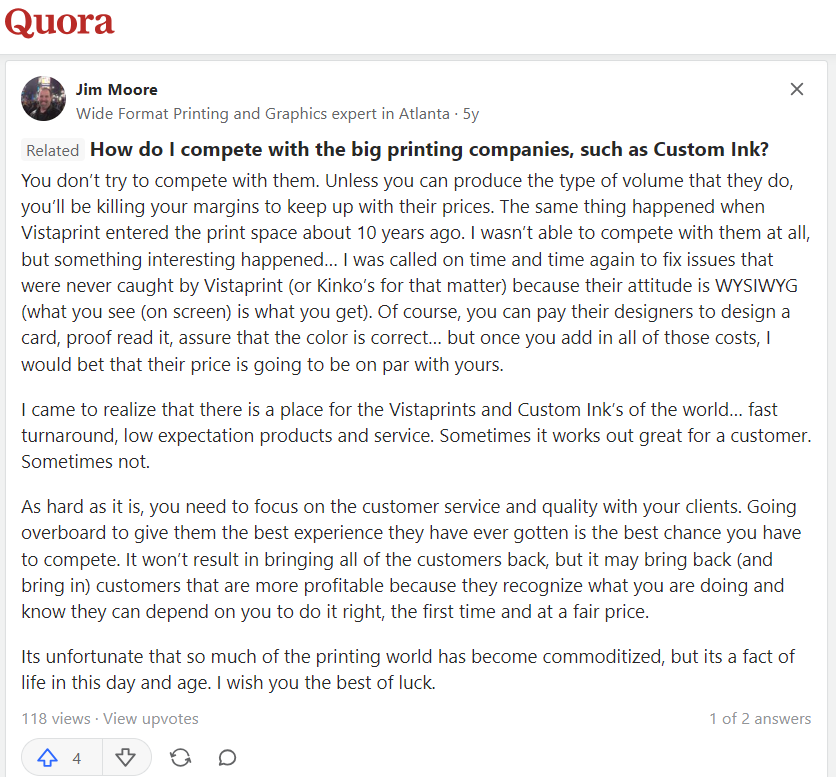
6. Intellectual Property Concerns
Starting a print-on-demand business means you need to be compliant with the law. First, you might need to register your business. Then, get any necessary licenses which depends on where you live. It's super important to make sure you're allowed to use any designs or text you print on products.
Visua data show that 70% of custom print-on-demand companies are not adhering to copyright and trademark laws. This suggests that majority of these businesses are using copyright materials. It could involve copying designs, logos, or other protected content without the permission of the original creators or owners. Thus, it lead to legal issues for these companies and affect the rights of the original content creators.
Using someone else's copyrighted material without permission could land you in trouble. You also have to ensure the products you sell are safe, and you're clear about how you handle and protect your customers' personal information.
7. Integration Issues
Integration issues on POD platforms can occur, disrupting this smooth operation. Such problems might lead to errors in order processing, delays in product delivery, and inaccuracies in inventory tracking. So, these issues can negatively impact the customer experience. As a result, leads to dissatisfaction and affect the store's reputation and sales.
The Reddit post by Severe_Bowl_6479 shares a detailed account of their negative experience with Printful, a company that offers print-on-demand services for clothing brands. The user shares successful e-commerce clothing brand, utilized Printful for about 8 months but ultimately decided to leave due to several significant issues.
These problems include managing product quality, ensuring accurate fulfillment, dealing with customer service inconsistencies, and financial viability due to high costs and low margins. The experience underscores the importance of thoroughly evaluating third-party services for integration into one's business to avoid negative impacts on customer satisfaction, brand reputation, and overall business profitability.
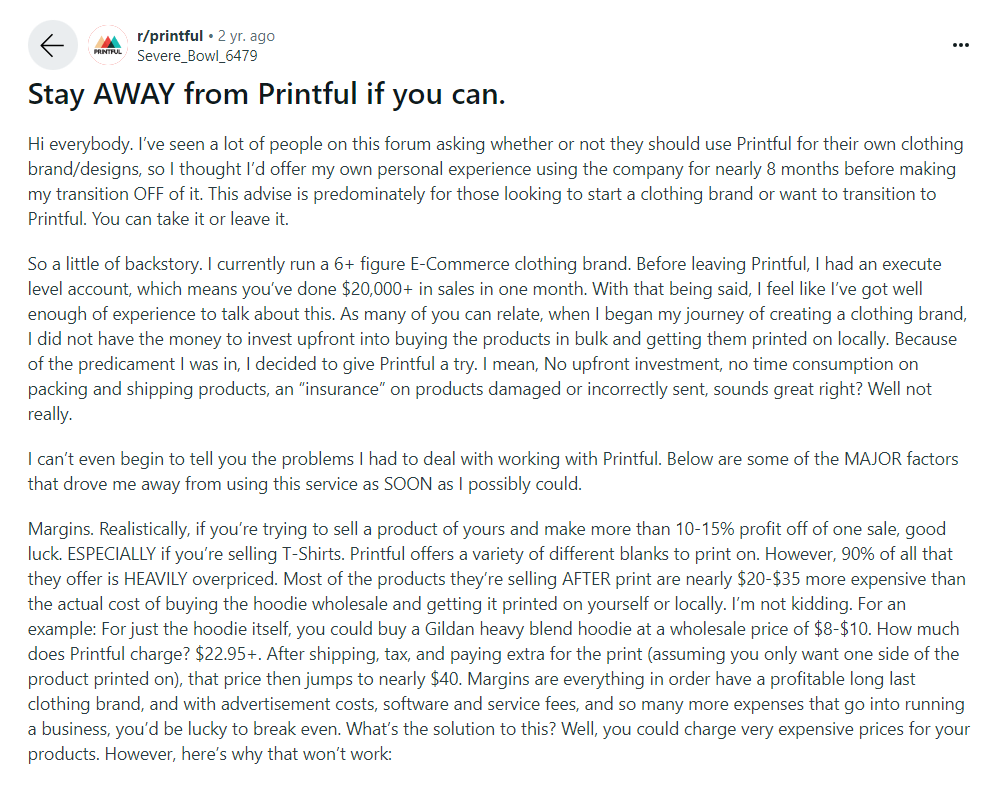

8. Low profit margins
The profit margin of print-on-demand businesses is 20% to 50%, but this can vary depending on the platform you use. Printify, for example, allows free account creation for sellers, but there's an annual subscription fee of $299. Production cost, shipping fees, taxes, and design fees (if applicable) are all deducted from your earnings.

CokimboTrend on Reddit commented that making good profits with print-on-demand is like winning the lottery. He had no luck with the business, his best days only made $50 in sales.

TheRealBritishOne also shared that profit with print-on-demand comes down to design and profits. He found selling higher-priced items more profitable instead of selling personalized t-shirts and mugs.
9. Dependency on Paid Tools
The print-on-demand business can be heavily dependent on paid tools for graphic and design, online store mock up, email marketing, social media management and engagement, and optimization. You need to pay a fixed fee on these tools every month, whether or not you're making good revenue with your POD business.
In print-on-demand, you incur recurring costs without guaranteed profits. For example, Canva for Teams costs $14.99, Figma Enterprise costs $75 monthly, and Mailchimp Premium (for email marketing) costs $175 for 12 months.
10. Artistic Expression VS. Profitability
One of the cons of print-on-demand is you always have to find the right balance between artistic expression and profitability. This means designing products that differentiate you in a crowded market while ensuring you meet the demands and preference of your target audience.
The seller's creative ideas don't always align with what's profitable in the market. Creating designs based on interest and passion can be really fulfilling, but if you want to make an income with POD, you might need to cut corners.
Your design should always resonate the demand of your target customers. Profitable sellers always prioritize trendy designs over their personal choices because these are more profitable.
What Are the Real-Life Challenges of Print on Demand Business?
The real-life challenges of print on demand are high competition, lack of control because of third-party dependency, maintaining product consistency, order fulfillment delays, and scalability limitations. The POD platform you use can also be a challenge if you don't know how to use and optimize it.
Reddit user joeyoungblood shares his bad experience with Printify. First, Printify fails to update WooCommerce sites when products go out of stock. This lead to sales of unavailable items. This has been a problem for over three years. With Printify either denying the issue or not addressing it, it complicates both paid and organic sales.
Additionally, the mockup selector tool is flawed. As a result, it adds all mockups to the user's site and sometimes mismatching or omitting designs. The user believes fixing these problems would greatly ease scaling and increase sales, but is frustrated by Printify's inaction.
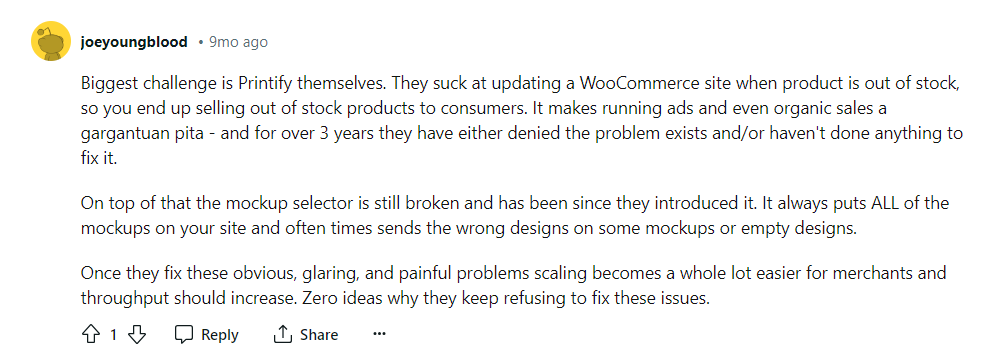
Another Reddit user yashmsllc is new to the POD industry. He is seeking advice from fellow creators due to facing several challenges.
Etsy India has stopped accepting new sellers. This leaves Yash in search of alternative platforms for selling art in India. Additionally, Yash's application to Merch by Amazon was also rejected without detailed feedback. Thus, it prompts a quest for other POD platforms or strategies to succeed in this area.
Yash encourages other creators to share who encountered similar issues. Or those who found success on different platforms. This is to overcome the hurdles together and find new opportunities in the online art and POD market.
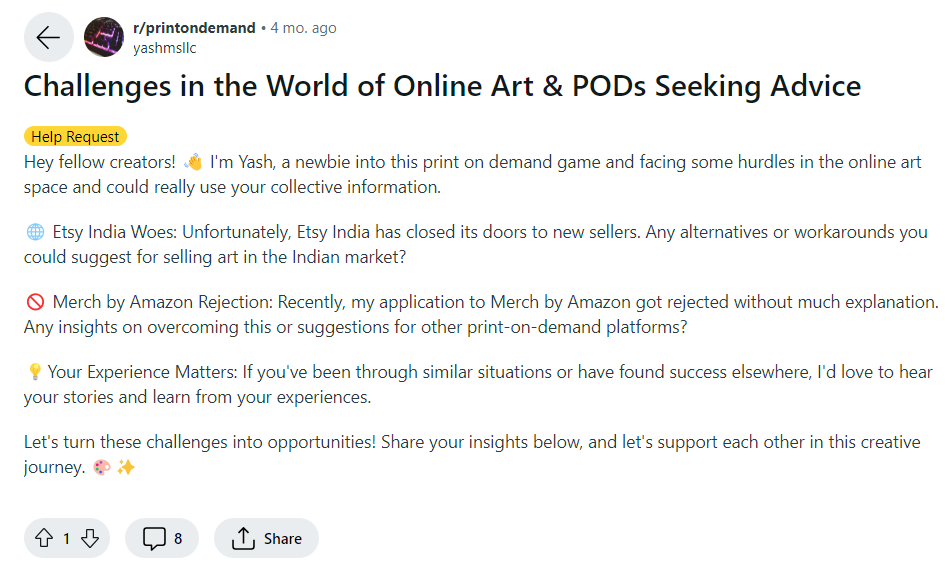
User DigitalTime's Quora post lists print-on-demand sellers' common problems: limited unique designs, high costs, shipping fees, promotions, pricing, low ad budgets, insufficient team support, potential returns, and forecasting issues.
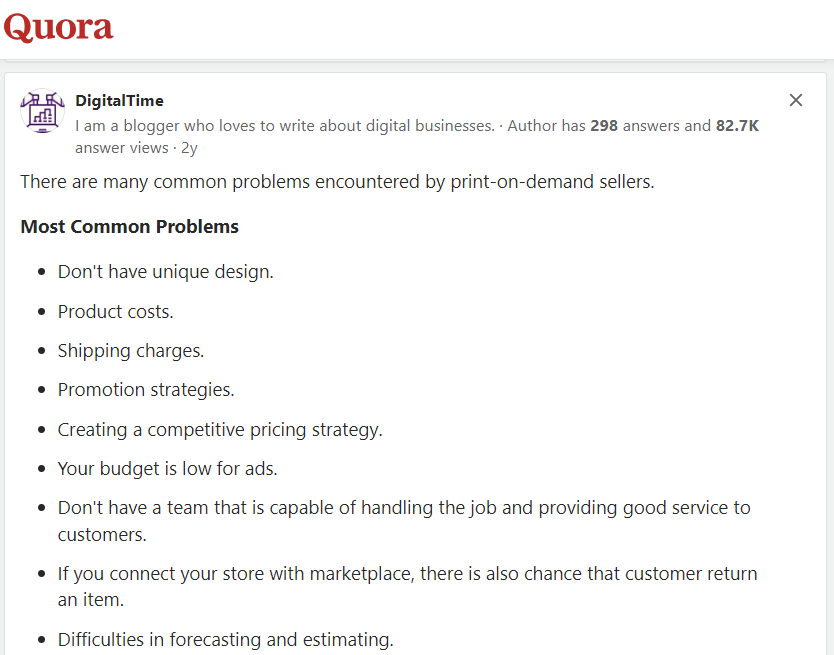
Can You Actually Make A Profit with Print on Demand?
Yes, you can make a profit with print-on-demand if you choose the right niche, create original, appealing designs, prioritize the quality of your products, and optimize your product's pricing. You should also experiment with different marketing strategies to find which one works best for you.
Do social media marketing, content marketing, and email marketing on Instagram, Pinterest, and Facebook to drive organic traffic to your POD store. Run discounts and promotions through limited-time offers to increase your sales volume. Experiment with different marketing strategies, and use analytics to understand what works and what doesn’t. Adjust your strategies according to optimize your marketing and sales process.
If you implement these right, you can make your print on demand business profitable.
Alex's Testimonial: Realistic Income with Print-on-Demand While Having A 9-To-5 Job

Alex's Background and Story
Alex is running a print-on-demand business on Etsy while working a full-time job. She shares her realistic earnings and challenges encountered in the business 6 months since she started print-on-demand. Her current Etsy shop is already her 4th attempt on print-on-demand. The first three ended up as failures.
Alex's Realistic Earnings with Print on Demand
In her first two months (May and June), Alex admitted she did not make a single sale. She bagged her first order in July, which only totalled $6. By August, her Etsy shop had seven orders that brought her $157.90 in sales. She received seven orders again in September that totalled $171.60 and this further went up by $469 after she closed 14 orders in October. Alex's Etsy store made $1,146.60 revenue over a 6-month period.
The Challenges Alex Faced
What's not mentioned in the video: Alex made $1,146.60 revenue in six months, but she did not mention how much of it was profit. Print-on-demand profit margins are from 20% to 50%. Taking the conservative average, Alex's net profit in six months is at least $229, which is pretty fair, considering it's a new store that's still gaining traction.
What is the Success Rate of a Print on Demand Business?
The success rate of the print on demand business model is 24%. This means only 2 to 3 out 10 who try the print on demand biz make a substantial income out of it. North America dominates this industry with 35% revenue share. One factor that contributes to this is that the biggest POD platforms like Printful, Printify, and Zazzle are all headquartered in the United States.
Why It's Time to Shift From Print on Demand to Local Lead Generation
It's time to shift from print on demand to local lead generation because the latter opens opportunity for steady income with no to less upfront fees.
According to WebFX, 96% of people discovering local businesses through the internet and 80% of local searches. This leads to conversions. It's clear that a strong online presence can impact a business's ability to attract and convert potential customers. Thus, engaging in local SEO enhances your ability to connect with and convert local leads in no time.
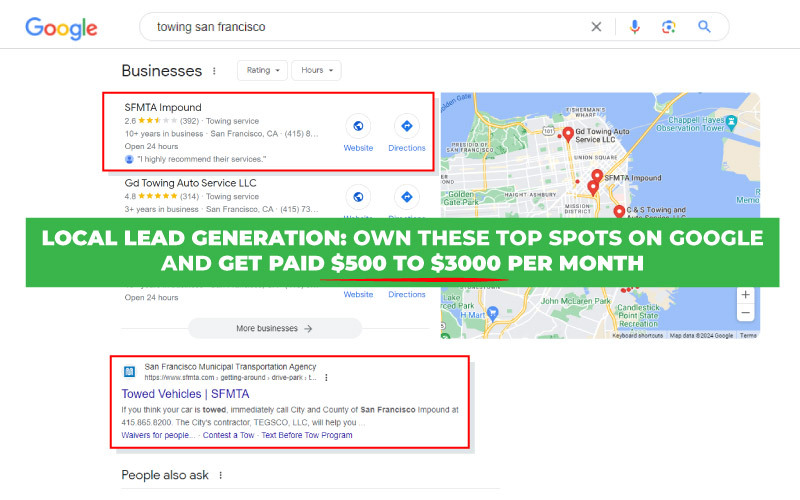
Since local lead generation requires a lower investment compared to print on demand, it doesn’t require inventory or significant upfront investment in product development. However, POD involves creating and selling custom products without holding inventory. This may reduce the risk but it depends on finding unique designs and products that appeal to consumers.
While both models are scalable, local lead generation can scale more passively. Once the initial setup website or launching a digital campaign is done, these assets can continue to generate leads with minimal effort. This scalability allows for the generation of passive income. This is because the system can operate and generate revenue even when you're not actively working on it.
Ultimately, local lead generation can provide a sustainable source of passive income through the efficient use of digital marketing strategies to capture and sell leads. Its scalability, potential for automation, and lower risk compared to product-based business models like print on demand make it an attractive option for entrepreneurs looking to build a business with long-term income potential.

